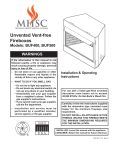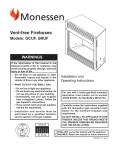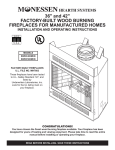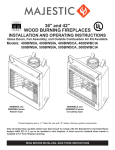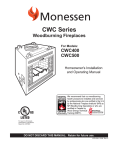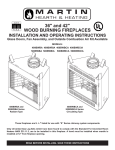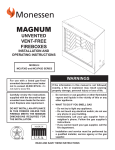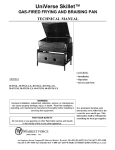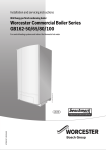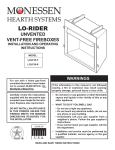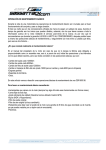Download MHSC BUF400 Operating instructions
Transcript
UNVENTED VENTFREE FIREBOXES INSTALLATION AND OPERATING INSTRUCTIONS MODELS: BUF400 BUF500 For use with a listed gas-fired unvented decorative room heater not to exceed 40,000 BTU/hr. Do Not Build a Wood Fire. Carefully review the instructions supplied with the decorative type unvented room heater for the minimum fireplace size requirement. Do not install an appliance in this firebox unless this firebox meets the minimum dimensions required for the installation. WARNINGS WARNINGS WARNINGS If the information in this manual is not followed exactly, a fire or explosion may result causing If the information in this manual is not followed exactly, property damage, personal injury or loss of life. a fire or explosion may result causing property damage, personal injury oror loss ofgasoline life. – Do not store use or other flammable vapors and liquids the vicinity of this or any – Do not store or use in gasoline or other flammable other appliance. vapors and liquids in the vicinity of this or any other appliance. – WHAT TO DO IF YOU SMELL GAS – WHAT TO DO IF YOU SMELL GAS • Do not try to light any appliance. • to light appliance. • Do Do not nottry touch anyany electrical switch; do not use • Do not touch any electrical switch; do not use any any phone in your building. phone in your building. • Immediately call your gas supplier from a • Immediately call your gas supplier from a neighbor's neighbor's phone. Follow the gas supplier's phone. Follow the gas supplier's instructions. instructions. • If you cannot reach your gas supplier, call the fire • department. If you cannot reach your gas supplier, call the fire department. – Installation and service must be performed by – aInstallation and service must be performed by qualified installer, service agency or the gas a qualified installer, service agency or the gas supplier. supplier. READ AND SAVE THESE INSTRUCTIONS 61D1013 2/10 Rev. 8 CONTENTS Important Safety Information.................................. 3 Product Features.......................................................5 Before You Start......................................................5 General Installation Information..............................6 Firebox External Dimensions..................................6 Minimum Hearth Dimensions..................................7 Location of Fireplace................................................7 Clearances and Height Requirements.....................8 Fireplace Framing...................................................10 Gas Line Installation...............................................12 Canopy and Radiant Face Plates Installation.......13 Other Optional Equipment......................................14 Forced Air Kit........................................................14 Brass or Chrome Louvers.....................................14 Brass or Chrome Trim...........................................14 Firebrick................................................................14 Optional Wide Canopy..........................................14 Illustrated Parts Breakdown...................................15 Using Optional Outside Air Kit...............................16 Warranty...................................................Back Cover 61D1013 IMPORTANT SAFETY INFORMATION INSTALLER OWNER Please leave these instructions with the appliPlease retain these instructions for future referance. ence. IMPORTANT WARNING Read these instructions carefully before installing or trying to operate a vent-free gas heater in this firebox. •Any change to this heater or its controls can be dangerous. •Improper installation or use of the heater can cause serious injury or death from fire, burns, explosion or carbon monoxide poisoning. •Do not allow fans to blow directly into the fireplace. Avoid any drafts that alter burner flame patterns. •Do not use a blower insert, heat exchanger insert or other accessory, not approved for use with this heater where applicable. 1. Due to high temperatures, the appliance should be located out of traffic and away from furniture and draperies. 9. The installation must conform with local codes or, in the absence of local codes, with the National Fuel Gas Code, ANSI Z223.l/NFPA54. 2. Children and adults should be alerted to the hazard of high surface temperature and should stay away to avoid burns or clothing ignition. 10.This unit complies with ANSI Z21.91.2001 ventless firebox enclosures for gas-fired unvented decorative room heaters. 3. Young children should be carefully supervised when they are in the same room with the apliance. 11.Do not install heater in a bathroom or bedroom. 4. Do not place clothing or other flammable material on or near the appliance. 5. Any safety screen or guard removed for servicing an appliance, must be replaced prior to operating the heater. 6. Installation and repair should be done by a qualified service person. 7. To prevent malfunction and/or sooting, an unvented gas heater should be cleaned before use at least annually by a professional service person. More frequent cleaning may be required due to excessive lint from carpeting, bedding material, etc. It is imperative that control compartments, burners and circulating air passageways be kept clean. 8. CARBON MONOXIDE POISONING: Early signs of carbon monoxide poisoning are similar to the flu with headaches, dizziness and/or nausea. If you have these signs, obtain fresh air immediately. Have the heater serviced as it may not be operating properly. 61D1013 12. Correct installation of the ceramic fiber logs, proper location of the heater, and annual cleaning are necessary to avoid potential problems with sooting. Sooting, resulting from improper installation or operation, can settle on surfaces outside the fireplace. See log placement instructions for proper installation. 13. Avoid any drafts that alter burner flame patterns. Do not allow fans to blow directly into fireplace. Do not place a blower inside burn area of firebox. Ceiling fans may create drafts that alter burner flame patterns. Sooting and improper burning will occur. 14. Caution: Candles, incense, oil lamps, etc. produce combustion byproducts including soot. Vent-free appliances will not filter or clean soot produced by these types of products. In addition, the smoke and/or aromatics (scents) may be reburnt in the vent-free appliance which can produce odors. It is recommended to minimize the use of candles, incense, etc. while the vent-free appliance is in operation. Continued on page 4 IMPORTANT SAFETY INFORMATION Continued from page 3 15. An unvented gas-fired heater uses air (oxygen) from the room in which it is installed. Provisions for adequate combustion and ventilation air must be provided. See installation guidelines. 16. Keep room area clear and free from combustible materials, gasoline and other flammable vapors and liquids. 17. Unvented gas heaters are a supplemental zone heater. They are not intended to be a primary heating appliance. 18. Unvented gas heaters emit moisture into the living area. In most homes of average construction, this does not pose a problem. In houses of extremely tight construction, additional mechanical ventilation is recommended. 23. Do not use this room heater if any part has been under water. Immediately call a qualified service technician to inspect the room heater and to replace any part of the control system and any gas control which has been under water. 24. Never burn solid fuels in a fireplace where a unvented room heater is installed. 25. Always have a fireplace screen in place when the appliance is in operation, and unless other provisions for combustion air are provided, the screen shall have an opening(s) for induction of combustion air. 26. Do not fill spaces around the firebox with insulation or other materials. These spaces must be maintained to prevent the firebox from coming in contact with combustible materials. 19. During manufacturing, fabricating and shipping, various components of this appliance are treated with certain oils, films or bonding agents. These chemicals are not harmful but may produce annoying smoke and smells as they are burned off during the initial operation of the appliance; possibly causing headaches, or eye or lung irritation. This is a normal and temporary occurrence. 20. Input ratings are shown in BTU per hour and are for elevations up to 2,000 feet. For elevations above 2,000 feet, input ratings should be reduced 4 percent for each 1,000 feet above sea level. Refer to the National Fuel Gas Code. www.nficertified.org WARNING The initial break-in operation should last two to three hours with the burner at the highest setting. Provide maximum ventilation by opening windows or doors to allow odors to dissipate. Any odors remaining after this initial break-in period will be slight and will disappear with continued use. We suggest that our gas hearth products be installed and serviced by professionals who are certified in the U.S. by the National Fireplace Institute® (NFI) as Gas Specialists. Never connect unit to private (non-utility) gas wells. This gas is commonly known as wellhead gas. 21. The appliance and its appliance main gas valve must be disconnected from the gas supply piping system during any pressure testing of that system at test pressures in excess of 1/2 psig (3.5 kPa). 22. The appliance must be isolated from the gas supply piping system by closing its equipment shutoff valve during any pressure testing of the gas supply piping system at test pressures equal to or less than 1/2 psig (3.5 kPa). 61D1013 WARNING product features Do not attempt to burn solid wood fuels, vented gas log sets, or any other combustible in this unvented firebox. Also, do not install a vent-free gas log set in this firebox if the minimum clearance and height requirements of the log set are too large for the firebox. The BUF400 and BUF500 are vent-free fireboxes and feature a self contained heat-circulating system. This unit also features a 2-in1, flexible-face system that converts the circulating system into a radiant system in seconds. This installation manual will enable you to obtain a safe, efficient and dependable installation of your vent-free fireplace system. Do not alter or modify the firebox or its components under any circumstances. Any modification or alteration of the firebox system, including but not limited to the firebox and accessories, may void the warranty, listings and approvals of this system and could result in an unsafe and potentially dangerous installation. BEFORE YOU START Carefully inspect the contents for shipping damage. If any parts are missing or damaged, immediately inform the dealer from whom you purchased the appliance. Do not attempt to install any part of the appliance unless you have all the parts in good condition. Make sure you have received all parts Check your packing list to verify that all listed parts have been received. You should have the following: 1. Vent-Free Gas Firebox 3.Five (5) sheet metal screws for canopy 2. Canopy 4.Installation and Operating Instructions What you will need for installation TOOLS BUILDING SUPPLIES • Phillips screwdriver •Square •Framing materials • Hammer •Piping complying with local codes •Wall finishing materials • Saw and/or sabersaw •Tee joint •Caulking material (noncombustible) • Level tible) •Pipe wrench •Fireplace surround materials (noncombus- • Measuring tape •Pliers • Electric drill and bits •Pipe sealant approved for use with propane/L.P.G. (resistant to sulfur compounds) notice Refer to the installation instructions provided with the log sets for items required for log set installation. Illustrations shown in this manual reflect “typical” installations with nominal dimensions and are for design and framing reference only. Actual installations may vary due to individual design preferences. However, always maintain minimum clearances to combustible materials and do not violate any specific installation requirements. 61D1013 GENERAL INSTALLATION INFORMATION In planning the installation for the appliance it is necessary to determine where the unit is to be installed and whether optional accessories are desired. Gas supply piping should also be planned. The following steps represent the normal sequence of installation. Each installation is unique, however, and might require a different sequence. 1. Position firebox prior to framing or into prepared framing. 2. Field wire main power supply to models with fan kit. (Electrical connections should only be performed by an experienced, licensed /certified tradesman). Electrical outlet is needed with fan kit. 3. Plumb gas line. (Gas connections should only be performed by an experienced, licensed/certified tradesman). 4. Install vent-free gas log heater per the instructions provided with the vent-free gas log heater. 5. Complete finish wall material, surround and optional hearth extension to your individual taste. FIREBOX EXTERNAL DIMENSIONS BUF400: 2413/16" BUF500: 3013/16" 21" 241/4" BUF400: 40" BUF500: 46" 2" BUF400: 36" BUF500: 42" 61/2" 219/16" 34" 69/16" 6" 103/8" 23/16" 14 /16" 7 Figure 1 - Firebox Dimensions 61D1013 GENERAL INSTALLATION INFORMATION BU BU F40 F5 0: 2 00 03 : 2 /8" 6 3/ 8" MINIMUM HEARTH DIMENSIONS 21 " 1/2 " 2 1/ " 2 35 1 / 0: 41 40 : F 00 U 5 B UF B " 17 Figure 2 - Minimum Hearth Dimensions location of firebox Carefully select the best location for installation of your vent-free firebox. The following factors should be taken into consideration: • Clearance to side wall, ceiling, woodwork and windows. See “Clearances/Height Requirements on page 8. Minimum clearances to combustibles must be maintained. • Location must not be affected by drafts caused by kitchen exhaust fans, ceiling fans, return air registers for forced air furnaces / air conditioners, windows or doors. • Installation must provide adequate ventilation and combustion air. • DO NOT INSTALL THIS FIREBOX IN A BEDROOM OR BATHROOM. Figure 3 - Location of Firebox • Location should be out of high traffic or windy or drafty areas. • DO NOT INSTALL WHERE CURTAINS, FURNITURE, CLOTHING OR OTHER FLAMMABLE OBJECTS ARE LESS THAN 42" FROM FRONT OF HEATER. • Never obstruct the front opening of the vent-free firebox or restrict the flow of combustion and ventilation air. • Minimize modifications to existing construction. Refer to Figure 3 below for location suggestions. • Do not install in the vicinity where gasoline or other flammable liquids may be stored. The vent-free firebox must be kept clear and free from these combustible materials. 61D1013 CLEARANCES and HEIGHT REQUIREMENTS Ensure that minimum clearances shown in Figures 4 through 7 are maintained. Left and right clearances are determined when facing the front of the firebox. Follow these instructions carefully to ensure safe installation. Failure to follow these requirements may create a fire hazard. 1. Sidewall clearances: The clearance from the inside of the appliance to any combustible wall should not be less than 9". See Figure 4. 2. Ceiling clearance: The ceiling must be at least 42” from the top of the firebox opening. See Figure 4. 3. Back wall clearnace: The appliance may be placed against a combustible back wall. Mi 42" nim um Mi 9" nim u m Mi 9" nim u m Figure 4 - Clearance and Height Requirements Continued on page 10 61D1013 CLEARANCES and HEIGHT REQUIREMENTS 4. Mantel clearances: The canopy supplied with the unit must be installed. If a combustible mantel is installed, it must meet the clearance requirements as shown in Figure 5. 12" 10" 8" 6" 23" 21/2" 16" 19" 21" 12" Figure 5 - Mantel Clearances 5. Floor clearance: This inner chamber firebox floor must be installed at least 5" above any combustible flooring material, such as carpeting or asphalt tile, which is closer than 14" to the base of the firebox. See Figure 6. Or The inner chamber firebox floor may be installed nearer to the floor if a minimum of 14" of noncombustible material such as slate or marble is installed between the base of the firebox and the combustible flooring. See Figure 7. Non-Combustible Material Can Be Less than 5" Non-Combustible Material 5" Minimum Figure 6 - Minimum Clearance above Combustible Flooring 61D1013 14" Minimum Figure 7 - Minimum Clearance above Combustible Flooring with Non-Combustible Material Installed at Base of Fireplace fireplace framing Firebox framing can be built before or after the appliance is set in place. Construct firebox framing following Figures 8 through 11 and the chart below for your specific installation requirements. See Figure 1 on Page 6 for firebox dimensions. The framing headers may rest on the top of the firebox standoffs. WARNING The firebox may be installed directly on a combustible floor or raised on a platform of an appropriate height. When the firebox is installed directly on carpeting, tile, or other combustible material, other than wood flooring, the firebox shall be installed on a metal or wood panel extending the full width and depth of the enclosure. Do not fill spaces around firebox with insulation or other materials. This could cause a fire. /" " / 51 400: 123/4" 500: 16" 3 4 3 8 46 0: 40 00: 5 400: 2413 /16" 500: 3013/16" 400: 401/4" 500: 461/4" 400: 331/16" 500: 365/16" 205/16" 400: 241313/16" 500: 30 /16" 400: 661/8" 500: 725/8" Figure 8 - Corner Installation 203/4" 400: 4011/4" 500: 46 /4" /2" or 5/8" 1 Figure 9 - Inside Chase Installation 400: 2413/16" 500: 3013/16" 341/4" 203/4" 400: 401/4" 500: 461/4" Figure 10 - Stud Location 400: 403/4" 500: 463/4" /2" or 5/8" 1 Figure 11 - Recessed Installation 10 61D1013 WARNING fireplace framing The fireplace must be installed giving full consideration to the clearance and height requirements identified in this manual. 1. Bend out the nailing flanges located on each side of the firebox. 2. Slide the firebox into prepared framing or position firebox in its final position and frame later. 3. Level the firebox by checking the top edge of the firebox. Shim if necessary. 4. Anchor firebox to the side framing members using 8d nails or other suitable fasteners. See Figure 12. 5. The canopy must be installed for safe operation of the heater. See page 13 for canopy installation details. Nail Sides Through Nailing Flanges Figure 12 - Location of Nailing Flanges 61D1013 11 WARNING gas line installation Plumbing connections should only be performed by a qualified, licensed plumber. Main gas supply must be off when plumbing gas line to fireplace or performing service. Consult all local codes. All gas piping must be installed to comply with local codes, or in the absence of local codes, with the latest edition of the National Fuel Gas Code ANSI Z223.1/NFPA54. Remove the baseplate for ease of gas line installation. Remove three (3) screws along the front edge of the baseplate. Remove four (4) screws which secure the baseplate to the combustion casing (two at rear and one along each side). Replace baseplate prior to connecting gas line to heater. Consult heater installation and operating instructions for correct installation of the heater into the firebox. The 1/2" gas line may enter either from the left side or right side of the firebox. Gas access holes are provided on both sides of the firebox. A listed manual shutoff valve must be installed upstream of the appliance. A union tee and plugged 1/8" NPT pressure tapping point should be installed upstream of hte appliance. IMPORTANT: Install main gas valve (equipment shutoff valve) in an accessible location. The main gas valve is for turning on or shutting off the gas to the fireplace. A sediment trap may be upstream of the heater to prevent moisture and contaminants from passing through trap to the heater controls and burners. Failure to do so could prevent the heater from operating reliably. Consult applicable codes. An external regulator must be used on all propane / L.P.G. heaters, in addition to the regulator fitted to the heater, to reduce the supply tank pressure to 13" w.c. (maximum). Any copper tubing used to supply propane / L.P.G. from the tank must be internally tinned. Note: When connecting propane / L.P.G. vent-free room heaters, you must use pipe sealant resistant to propane / L.P.G. Important: Hold heater regulator with a wrench to prevent movement when connecting to inlet piping. WARNING Check gas type: The gas supply must be the same as stated on the heater’s rating plate. If the gas supply is different, DO NOT INSTALL THE HEATER. Contact your dealer for the correct model. Connecting directly to an unregulated propane / L.P.G. tank can cause an explosion. WARNING After completing connection, test all gas joints from the gas meter to the gas heater regulator for leaks. Using soap and water solution or a gas sniffer. DO NOT USE AN OPEN FLAME. 12 Do not connect directly to natural gas 1/2 PSI or 2 PSI systems. Always make sure natural gas pressure is regulated 10.5 w.c. (maximum before operating the unit). 61D1013 canopy installation Installing canopy WARNING A canopy is furnished with each firebox and MUST be installed for safe operation. See Figure 14. The firebox canopy must not be modified or replaced with a canopy that may be provided with the unvented decorative room heater. 1. Locate three (3) holes at the top of the front frame. See Figure 13. 2. Align the canopy with the holes in the top of the frame. 3. Secure canopy to front of frame with screws provided. See Figure 13. Front Frame Canopy Screws WARNING Figure 13 - Installing Canopy 61D1013 Close fireplace screen panel before operating a decorative type unvented room heater. 13 optional equipment Forced Air Kit (FA2A) WARNING If you are installing the forced air kit, Model FA2A, see the installation instructions provided with the kit for electrical wiring requirements, or the blower installation section. The firebox must be connected to main power supply at time of firebox installation. The blower must be installed prior to the installation of the vent-free heater. The electrical connections must be made before the firebox is framed and enclosed in the finished walls. 14 Electrical connections should only be performed by a qualified, licensed electrician, main power must be off when connecting to main electrical power supply or performing service. The blower when installed, must be electrically grounded in accordance with local codes or in the absence of local codes, with the National Electrical Code ANSI/NFPA 70. 61D1013 illustrated parts list ITEM DESCRIPTIONQTY BUF400 BUF500 Canopy Screen Panel Screen Rod Rear Refractory Side Refractory Bottom Refractory Outside Air Kit 26D4568 26D0131 26D0132 61D0102 61D0101 61D0100 AK-4 1 2 3 4 5 6 7 1 2 2 1 2 1 1 26D4706 26D0187 26D0133 61D0107 61D0101 61D0106 AK-4 1 3 3 2 61D1013 15 for use of optional ak-4 outside air kit Combustion Air 1. Locate combustion air assembly at an exterior location which is not likely to be accidentally blocked in any manner. Locate assembly a min. of 12" above the snow line to prevent blockage by snow accumulation. 2. Never mount the combustion air inlet assembly in a garage or storage area where combustible fumes such as gasoline might be drawn into the fireplace. 3. Combustion air can be drawn from the crawl space under a house when an adequate supply of air is provided by open ventilation. 4. CAUTION: Do not take combustion air from attic space or garage space. 5. Locate air supply inlet at least 3' away from any appliance vent terminal. 6. Avoid extremely long runs and numerous turns in the duct leading from the fireplace to the combustion air assembly. These conditions increase the resistance to the free flow of air through the duct. See Figures 14 through 17 for methods of installing the outside air for combustion assemblies. Note: Fireplace model in illustrations may not be representative of your appliance. Above Snow Level Basement Wall Inlet Grill in 8'max. Soffit (Overhang) Ground Level Figure 15 - Concrete Slab Installation (Optional Outside Air Runs) Figure 14 - Basement Installation Inside Wall Duct Extended to Miss Joist To Outside Wall Figure 16 - Installation Above Basement or Crawl Space 16 Outside Wall Figure 17 - 45° Corner Installation on Slab Floor 61D1013 for use of optional ak-4 outside air kit Model AK-4 Combustion Air Assembly 1. Remove the cover plate from the 4" outlet opening location on the left or right outside of the fireplace. 2. Place the insulation ring between the AK-4 starting collar and fireplace wall. WARNING The use of outside air for combustion is optional unless required by building codes. It is only necessary to supply outside combustion air to one side of the fireplace. Use the model AK4 combustion air kit. DO NOT remove the cover if the outside air will not be connected. 3. Place the starting collar (4") into the hole on the side of fireplace. Fasten it in place with the four sheet metal screws provided. See Figures 18 and 19. Note: The air starting collar extends through the fireplace outer wrap. When the air starting collar is securely attached, it will form a seal against the fireplace wall. 4. Attach outside duct to starting collar with duct clamp or screws. See Figure 19. Left Side of Fireplace Insulation Ring Air Starting Collar Screws AK-4 Starting Collar Duct Sheet Meal Screws Left Side of Fireplace Shorter End of Air Starting Collar Figure 18 - Attaching Outside Air Starting Collar and Insulation Ring to Left Side of Fireplace 5. Cut a 6-inch diameter opening for model AK-4 in the outside wall covering where the outside vent is to be located. See Figure 20. Figure 19 - Attaching Outside Duct to Starting Collar 6" Diameter Hole Screw Nail Holes WARNING 6. Select and cut a piece of duct long enough to attach to the fireplace and stick out at least 3" beyond the face of the wall to which the AK-4 inlet air vent will be Duct attached. See Figure 19. Extending 3"min. Use FP-4 U duct for maximum efficiency and safety. Do not use a combustible duct. Always use UL Listed Class 0 or 1 duct material. AK-4 Inlet Air Vent Screws Figure 20 - Combustion Air Assembly for Model No. AK-4 Continued 61D1013 17 for use of optional ak-4 outside air kit Model AK-4 Combustion Air Assembly (continued) 7. If the duct is the insulated type, push the insulation back from one end of the duct approximately 2". See Figure 21. 8. Slip the exposed end of the duct over the starting collar on the fireplace. Duct Connector Approximately 2" 9. Using the sheet metal screws provided, secure the duct end to the collar attached to the fireplace. Insulation 10.Nail or screw the combustion air assembly to the surface of the wall. Note: If the wall covering is brick or stone, use appropriate masonry fasteners. If necessary, splice the duct. Use a model 403-duct connector to splice duct sections. Duct Clamp Figure 21 - Installing Duct Connector 403 Installing model 403 duct connector 1. Push insulation back approximately 2" from the end of each duct. 2. Slip each duct over duct connector until an equal length of connector extends into each duct. 3. Place duck clamp over the end of each duct. Tighten duct clamp down snuggly. 4. Push insulation back into place and over duct clamp. 18 61D1013 61D1013 19 LIMITED LIFETIME WARRANTY POLICY The following components are warranted for life to the original owner, subject of proof of purchase: Firebox, Combustion Chamber, Heat Exchanger, Grate, and Stainless Steel Burners. Five Year Warranty The following components are warranted for 5 years to the original owner, subject of proof of purchase: Vent Free Ceramic Fiber Logs, Catalytic Filter and Aluminized Burners. Basic Warranty MHSC warrants the components and materials in your gas appliance to be free from manufacturing and material defects for a period of two years from date of installation. After installation, if any of the components manufactured by MHSC in the appliance are found to be defective in materials or workmanship, MHSC will, at its option, replace or repair the defective components at no charge to the original owner. MHSC will also pay for reasonable labor costs incurred in replacing or repairing such components for a period of two years from the date of installation. Any products presented for warranty repair must be accompanied by a dated proof of purchase. This Limited Lifetime Warranty will be void if the appliance is not installed by a qualified installer in accordance with the installation instructions. The Limited Lifetime Warranty will also be void if the appliance is not operated and maintained according to the operating instructions supplied with the appliance, and does not extend to (1) firebox/burner assembly damage by accident, neglect, misuse, abuse, alteration, negligence of others, including the installation thereof by unqualified installers, (2) the costs of removal, reinstallation or transportation of defective parts on the appliance, or (3) incidental or consequential damage. All service work must be performed by an authorized service representative. This warranty is expressly in lieu of other warranties, express or implied, including the warranty of merchantability of fitness for purpose and of all other obligations or liabilities. MHSC does not assume for it any other obligations or liability in connection with the sale or use of the appliance. In states that do not allow limitations on how long an implied warranty lasts, or do not allow exclusion of indirect damage, those limitations of exclusions may not apply to you. You may also have additional rights not covered in this Limited Lifetime Warranty. MHSC reserves the right to investigate any and all claims against the Limited Lifetime Warranty and decide upon method of settlement. IF WARRANTY SERVICE IS NEEDED... 1. Contact your supplier. Make sure you have your warranty, your sales receipt and the model/serial number of your MHSCC product. 2. DO NOT ATTEMPT TO DO ANY SERVICE WORK YOURSELF. MHSC 149 Cleveland Drive • Paris, Kentucky 40361 www.mhsc.com




















